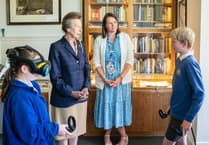TRAVELLERS along today’s A3 road between Portsmouth and London can have little concept of how wild and dangerous this route was only a few generations ago.
The steep gradients and thick vegetation either side of the road, particularly at Butser Hill and Hindhead’s Devil’s Punch Bowl, were formidable obstacles when the only transport was horse-drawn.
The coming of the railways and improved road engineering, as can be seen with the long cutting at Queen Elizabeth Country Park and the Hindhead tunnel, both of which improved safety and traffic flows on the trunk road, changed the landscape too. Excavation of the 6.5km-long tunnel started on February 1, 2008, and it was opened on July 23, 2011, by the then Transport Secretary Philip Hammond.
However, the Devil’s Punchbowl route, which was constructed in 1826, was not the earliest to cross this north-western edge of the Weald. The first direct route giving access between the capital city and the nation’s premier naval port was higher and to the east of both the tunnel and the old road by way of Gibbet Hill.
This 892-feet high Gibbet Hill and the nearby area were mentioned by Charles Dickens in Nicholas Nickleby when Nickleby and Smike are walking from London to Portsmouth.
“They walked upon the rim of the Devil’s Punch Bowl; and Smike listened with greedy interest as Nicholas read the inscription upon the stone which, reared upon that wild spot, tells of a murder committed there by night.
“The grass on which they stood, had once been dyed with gore; and the blood of the murdered man had run down, drop by drop, into the hollow which gives the place its name. ‘The Devil’s Bowl,’ thought Nicholas, as he looked into the void, ‘never held fitter liquor than that!’.”
The story of the sailor’s death in 1786 is just one of the features of The Historic Haslemere exhibition now on display at Haslemere Educational Museum.
Among the exhibits are five paintings, completed in about 1876 by an innkeeper named Pearson. They were displayed at the Royal Huts Hotel at Hindhead and later hung at The Kings Arms and Royal Hotel in Godalming.
Following the pub’s refurbishment in 2008, the paintings were sold at auction and bought by a private purchaser who then donated them to the museum in the town’s High Street.
Running at the same time is Byron Cooper – Tennyson’s Country, an exhibition showcasing the museum’s collection of works by the eminent Victorian artist, George Gordon Byron Cooper. The poetry of Alfred, Lord Tennyson, who lived on the slopes of Blackdown, inspired Byron Cooper to depict the dramatic landscapes and vivid emotions evoked in his prose.
Both exhibitions are at the museum until March 3, except Sundays and Mondays. Opening hours for the building and grounds are 10am to 5pm and admission is by donation.




